.
When my youngest son was in 7th grade, his school grades suddenly worsened and he became quieter and more introverted. At first, I thought it was probably normal, what with puberty and all, but one day he told me that he “didn’t get along with” (read: was bullied by) the boy sitting next to him. The moment he could change seats and get away from the bully, his grades got better and he was his usual easy-going self again.
What applies to people is even more valid for plants. Some thrive in each other’s vicinity while others just can’t stand one other. The concept of considering these veggie loves when planning a garden is called Companion Planting.
But who to pair and who to separate? Whether you want to start gardening on a tiny balcony or in a large backyard, I’m about to introduce you to some plant partnerships that are practically guaranteed to work out. Better still, these aren’t high-maintenance vegetables but easy-going duos that’ll make you soon famous for your green thumb. I know, companion planting can feel overwhelming – even if you have already some experience – but I’ve discovered some foolproof combinations that just work!
Before we grab our garden gloves and head out, though, let’s see what companion planting is and why it works.
What is companion planting?
Companion planting is a gardening technique where different plant species are grown near each other for mutual benefit.
Think of it as playdates in your garden. Just like people, plants can be great friends who help and support each other in all sorts of ways.
Some share nutrients that they gather with their neighbours, others are great at sharing space, like offering a bit of shade on hot days or becoming a live trellis their friends can climb.
Others are the bodyguards of the patch and keep pests and diseases away from their pals. can be paired to help each other by repelling pests, attracting beneficial insects, providing nutrients, offering physical support, or creating beneficial growing conditions like shade or ground cover.
Getting Started: Essential Tips for Success
Pairing great vegetable couples alone, however, will not make your garden a success. There are a few preparations you have to take and recommendations you should observe.
Soil type
First of all, get to know your garden’s soil type and make arrangements to adjust it if necessary. Don’t worry, it’s easier than it sounds and you can look at how to do it here.
Soil preparation
Loosen the soil on your patch with a hoe, remove all the debris and weeds and rake it even. Work in some compost and/or well-matured manure to enhance the soils nutrient content. If you start from scratch, I’ll show you here the easiest way to build a new garden patch without digging.
If you plant in containers, make sure you use high-quality planting soil that’s suitable for vegetables.
Spacing guidelines
It’s tempting to plant too close and even seasoned gardeners make that mistake from time to time (yep, that would be me). But: your vegetables won’t thrive when they haven’t got enough space. At the back of your seed packages is usually a space guideline which you should observe!
Timing
Depending on your growing zone, planting and sowing can differ by weeks. The first step is to find out your growing zone (for example here) and then to watch nature and observe the weather forecast. You should realize when day frosts are over and when the last night frosts will happen.
Basic tools
Apart from soil, you need a few tools for gardening. A large garden fork is great for digging in compost and manure if you have patches. A hand trowel and hand cultivator are essential for both container and patch gardening.
A rake (large or hand-sized) helps you to get the soil even.
Buy a good watering can for watering specific plants and seedlings. If you use a hose, make sure it has an adjustable nozzle.
For your own protection, you’ll need gardening gloves and maybe a knee pad.
If you want to cultivate a backyard garden, a wheelbarrow is a useful investment for carrying compost, manure or other heavy things around. Additionally, a bucket comes in handy for smaller amounts of soil or weeds.
The 10 Surefire Companion Planting Pairs
Now that we know how companion planting works and how to prepare our beds and containers, Here are some foolproof companion planting pairs that are guaranteed to be a success! I’ll show you how they benefit from each other and give you tips for growing.
No 1: Tomatoes and Basil

Pest control: Basil can prevent pests like spider mites, white flies or aphids and thus protect tomato plants from them. The basil’s essential oils either confuse or repel these pests. On the other side, basil attracts ladybirds, the natural antagonist of for example aphids.
Normally, you harvest basil before it blooms, but as we want to attract beneficial insects, let at least some blossoms start to bloom. (Not sure how you can preserve herbs? Take a look over here.)
Use of space: Tomatoes grow high while basil stays relatively short. In combining these two, you can use your garden space optimally while at the same time making sure that the tomatoes can shadow the sensitive basil and thus protect it from too much direct sunlight which would burn its leaves.
Ground cover: On the other side, basil covers the soil and prevents evaporation. This leads to constantly moist soil which is beneficial for the tomatoes.
Soil improvement: Basil loosens the soil with its shallow and well-branched roots and enables oxygen to get into the soil. Its structure supports the creation of a good microclimate around the tomatoes, strengthening their vitality and enhancing the harvest
Taste enhancement: Many gardeners have experienced that basil enhances the taste of tomatoes – not only on the plate but also when planted together.
Planting and growing tips
You can start growing tomatoes and basil indoors by sowing them about 6 weeks before you can plant them out which is after the last night frosts. When this will be depends on the zone you live in. (Not sure what your growing zone is? This page will help you find out). If you have a greenhouse, you can plant them out a few weeks earlier.
Basil grows best in a bit of shadow which the tomatoes easily provide. Both plants like it warm and protected from wind and rain.
Tomato plants need about 60 cm (25 inches) distance from each other, bush varieties about 40 cm (15 inches). Plant the basil between or around the tomatoes but not too close so that the leaves of both plants won’t touch.
If you plant in containers make sure they are large enough. A diameter of 30 cm (12 inches) is the minimum.
No 2: Carrots and Onions
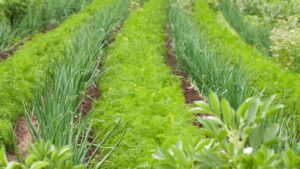
Pest control: Carrots keep the onion fly away while onions deter the carrot fly. Both plants absorb a scent that repels the pests.
Use of space: As carrots have deep roots and onions shallow ones, the combination of both guarantees an optimal use of gardening space. Besides, both plants get their water and nutrients from different zones of the soil and don’t compete.
Planting and growing tips
Loosen the soil with a digging fork before you sow and plant. This will make sure that the carrots can grow easily into the depth and build long straight roots.
Sow carrots and plant onions after the last day frosts and when the soil has warmed up. In my zone 7b this is around the beginning to mid-April. As carrots may need it a bit warmer, you can also plant the onions first and sow the carrots later when the soil has turned warmer. Make sure to keep enough space between the onion rows, so that there’s plenty of room for the carrots.
Carrots take their time to grow leaves which makes it hard to weed during the first weeks. To make it easier, mark the rows of carrots when you sow, either with a plant sticker or by sowing radishes between the carrots. They grow very fast and indicate soon where the rows are.
No 3: Cucumbers and Nasturtiums
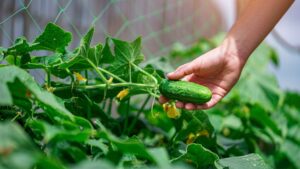
Pest control: Nasturtiums attract pests like aphids, white flies and squash bugs, thus acting like a trap and keeping the cucumbers relatively pest-free. In particular, nasturtium confuses and deters cucumber beetles, which are a major pest for cucumber plants. Additionally, nasturtium help deter soil nematodes.
With their beautiful flowers nasturtium attracts bees, butterflies and other pollinators. This can lead to higher fruit yield and a better harvest.
Use of space: Cucumbers are known to be avid climbers and grow on trellises. As nasturtiums grow low, they can be cultivated between the cucumber plants to optimally use the space.
Ground cover: Nasturtiums cover the ground between the cucumbers and shadow their roots. That way, they also prevent evaporation and help retain moisture in the soil. As cucumbers like moist soil, this is a great combination. Additionally, it prevents weed growth and keeps the soil cool.
Soil improvement: Nasturtiums also loosen the soil due to their root structure and that way enable oxygen to reach the cucumbers’ roots.
Taste enhancement: Nasturtium is said to improve the taste of cucumbers.
Edible flower bonus: If all that hasn’t convinced you, this is the absolute bonus: nasturtium not only looks pretty, its flowers (and leaves) are also edible and pimp every salad or the occasional pasta dish. If that’s no reason to grow nasturtium, I don’t know what is.
Planting and growing tips
Pre-cultivate cucumbers and nasturtium indoors by sowing them about 4 – 6 weeks before the last night frosts. Both like it warm and sunny and should not be planted out before it’s really warm enough.
No 4: Lettuce and Marigolds (tagetes)
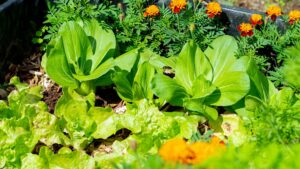
Pest protection: Marigolds are the SWAT team of pest protectors! Their strong sent, for example, repels aphids while secretions of their roots kill soil nematodes. At the same time, they deter leaf-eating pests from the salad and build a barrier against common garden pests like snails. If that’s not high-level natural pest control, I don’t know what is!
Soil improvement: Marigolds improve the soil structure with their robust root system which enables oxygen to get into the soil where it’s also beneficial for the lettuce.
It also provides organic material, for example when spent blooms fall off and decompose.
Ground cover: Both plants provide good ground cover for each other which makes the soil stay moist but also prevents weeds from growing.
Edible flower bonus: Some marigold varieties have edible flowers, for example tagetes lemmonii, tenuifolia and minuta
Planting and growing tips
The best way to plant marigolds and lettuce together is to cultivate a marigold border around salad patches. Plant the marigolds with a distance of 20 – 30 cm (8 – 12 inches). If you have a large lettuce patch, plant the occasional marigold between the lettuce.
No 5: Beans, Corn and Pumpkin

The trio of beans, corn and pumpkin is called the “Three Sisters”, a famous companion planting scheme from native Americans. They are cultivated together for the following benefits:
Structural support: Beans in this case means climbing beans. The corn stems provide a sturdy structure for the beans to climb up.
Use of space: Corn and beans grow high while pumpkin spreads along the ground which makes that the perfect example of an optimal use of space.
Soil improvement: Beans are nitrogen-collectors which means that they gather nitrogen from the air and store it in their roots where the corn and pumpkin benefit from it. (Read more about plant nutrients here.) When the beans are harvested, cut them off above the ground and leave the roots there. That way, the nitrogen stays in the soil.
Ground cover: The spreading pumpkin provides a great ground cover, thus retaining moisture and preventing weeds from growing.
Planting and growing tips
Make sure to choose the right varieties of beans and corn. Use mid to low-growing beans and strong-growing corn, otherwise, the beans will crush the corn stems.
It has also proven advantageous to choose coloured beans which makes it simpler to find them later in the thicket of the patch.
Sow corn about two weeks before the last night frosts (in zone 7b that’s the beginning of May) with a distance of 40 cm (16 inches) between plants and 60 – 80 cm (24 – 32 inches) between rows. Sow up to 3 beans around each corn and plant pumpkin between the rows with a distance of 2 m (6.5 feet) between the pumpkin plants.
You can even cultivate the “Three Sisters” small-scale in a container. Choose one with a diameter of at least 50 cm (20 inches), plant low-growing corn in the middle, 3 – 4 bush (!) beans at the container edge and between corn and beans one small pumpkin variety.
No 6: Radishes and Spinach
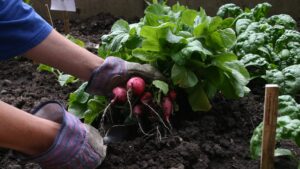
Pest control: Spinach’s strong scent can help repel certain insects, while radishes deter leave-eating pests.
Use of space: Radishes have deep roots and spinach develops shallow roots. That, in addition to them having similar requests regarding watering, makes those two vegetables a great example of how to use space efficiently.
Ground cover: Spinach covers the ground well with its large leaves and thus keeps the soil moist and prevents weeds.
Soil improvement: Furthermore, radishes help loosen the soil with their deep roots and thus support the more complex root system of spinach.
Planting and growing tips
Both, radishes and spinach can be sowed throughout the growth season, just make sure to pick the right varieties. You can start sowing spinach and radishes early in the year, in fact, after the last day frosts (here around that’s beginning to mid-April). Due to their relatively short growing time, both can be used as a gap filler or preparatory cultivation for plants that take a longer time to grow. There are also summer varieties which tolerate heat and, when sown every 6 – 8 weeks, ensure a continuous harvest from spring to autumn.
Radishes can be harvested after 3 – 5 weeks so that they won’t compete with spinach for nutrients.
No 7: Peppers and Oregano
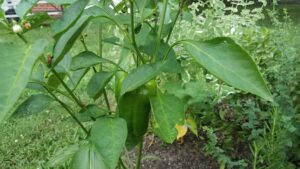
Pest control: Oregano releases a scent that repels certain pests like aphids, spider mites and other pepper-loving bugs. The scent can be so strong that it covers up the peppers’ scent so that pests can’t detect them.
Ground cover: Oregano, planted between and around peppers is a great ground cover which suppresses weeds and retains moisture in the soil. It also keeps the soil’s temperature stable and reduces soil splashing onto the pepper leaves during rain or watering, which minimises the risk of soil-borne diseases.
Flavour enhancement: Some gardeners report that oregano planted with peppers enhances their flavour. I personally haven’t had the same experience but maybe my taste buds aren’t refined enough 😊. Try it out and let me know what you think!
Planting and growing tips
Peppers and oregano enjoy the same sunny conditions and well-drained soil. But while peppers grow fast and vertical, oregano grows slower and stays more compact, thus building a good ground cover (see above). Both plants have different root depths and get their nutrients and water from different soil zones which means they don’t compete.
No 8: Zucchini and Nasturtiums
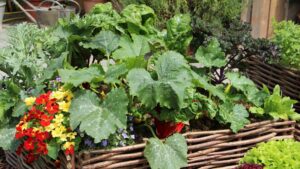
Zucchini and cucumbers are both members of the gourd family or Cucurbitaceae. Knowing that, it’s no wonder that zucchini, like cucumbers, pair well with nasturtiums.
Pest control: As described above, nasturtiums attract pests like aphids, white flies and squash bugs, keeping zucchini pest-free. Additionally, nasturtium helps deter soil nematodes.
Pollination benefits: Nasturtium with its large, beautiful flowers attracts bees, butterflies and other pollinators. This can lead to higher fruit yield and a better harvest.
Ground cover: Most gardeners know zucchini only as growing spaciously on the ground, but if you grow them vertically by binding them to a stick (yes, just like tomatoes), you not only save space but also keep the zucchini healthier. Nasturtium then works as a ground cover that keeps the soil moist and prevents weeds.
Planting and growing tips
Pre-cultivate zucchini and nasturtium indoors by sowing them about 4 – 6 weeks before the last night frosts. Both like it warm and sunny and should not be planted out before it’s really warm enough.
No 9: Peas and Carrots
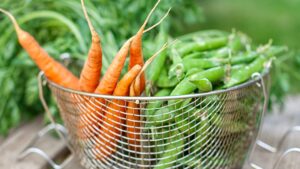
Use of space: The carrot tops are relatively sparse, allowing the pea vines to grow upwards. This vertical growth pattern allows you to grow more food in a smaller space.
Soil improvement: Peas (like beans) are nitrogen collectors; that means they gather nitrogen out of the air and store it in their roots where it’s partially available for the carrots. When the peas are harvested, cut them off shortly above the ground and leave their roots in the soil. That way, the nitrogen stored in their roots enhances the soil.
Peas have shallow roots whereas carrots develop deep taproots that go well into the ground. That way, both plants get their water and nutrients from different soil zones and don’t compete with one another.
Planting and growing tips
Peas are cool-season crops that can be planted early and carrots can either be sowed at the same time or slightly afterwards. By the time the carrots need more space for their roots, the peas will most likely be harvested and can be cut off. If you leave their roots in the ground, the carrots can access the nitrogen that’s stored in there.
No 10: Cabbage and Dill

Pest control: The strong scent that we love about dill, deters pests like cabbage white butterfly and aphids. Additionally, dill attracts insects like ladybugs, wasps and hoverflies that prey on cabbage pests.
Use of space: Dill grows upright and airy whereas cabbage shows a spreading form. Also, the root systems of those two don’t compete regarding water and nutrients as dill has shallow roots and cabbage has deep roots. That way, both plants can be cultivated well together, using garden space optimally.
Flavour enhancement: Some gardener’s say they perceive a flavour enhancement in cabbage when planted together with dill. I’d say, it’s worth a try!
Planting and growing tips
Both plants can be grown during the same seasons but dill grows a good deal faster than cabbage which allows for continuous garden use. When dill goes to seed, it can self-sow for the next season while cabbage continues growing.
Common Mistakes to Avoid

Companion planting is a great method to enhance your garden’s productivity but there are still some rules to observe. Here are some of the mistakes you should avoid:
Overcrowding
Even seasoned gardeners sometimes make this common mistake: planting companions too close together. Please bear in mind that all plants need their proper space for root growth and air circulation. By planting too close, you increase the risk of diseases and competition for resources instead of diminishing them.
Incompatible combinations
Make sure you know which plants get along well and which don’t. As described above, some plants inhibit growth in other plants. When you plant antagonists together, you needn’t wonder why your veggies don’t thrive.
Timing errors
Consider how long different vegetables need to be harvested. Some have a very short cultivation time (for example radishes), others are practically the whole season on the patch (cabbage). Use short-seasoned plants to fill the space until those who stay longer need more room.
However, it’s no good to combine vegetables with different plant windows. None of them will thrive.
Sunlight requirements
Sun lovers will become straggly in the shadow and the sun sensitives will get sunburnt in the blazing sun. Always plant veggies with similar sunlight requirements together. Also, take into consideration the shadow plants will cast on each other once they reach their final height.
Companion Planting – It’s worth the effort!
Companion planting can be a bit intimidating at first but you can make so much more of your patch if you bear in mind which pairs are love matches and which want to go at each other’s throats.
Whether you’re teaming up tomatoes and basil or letting beans and corn support each other, these combinations are practically guaranteed to succeed. Think of it as playing cupid with veggies – and these couples are definitely a match!
Still overwhelmed? There’s no need to put all the above into practice at once. Start slow and just try one or two of these tried-and-true pairs, watch them thrive together and before you know it, you’ll also be infected with the “garden bug” and want to try out more!
Now get out there, grab your garden gloves and a shovel and let these plant pals work their magic in your garden!🌱

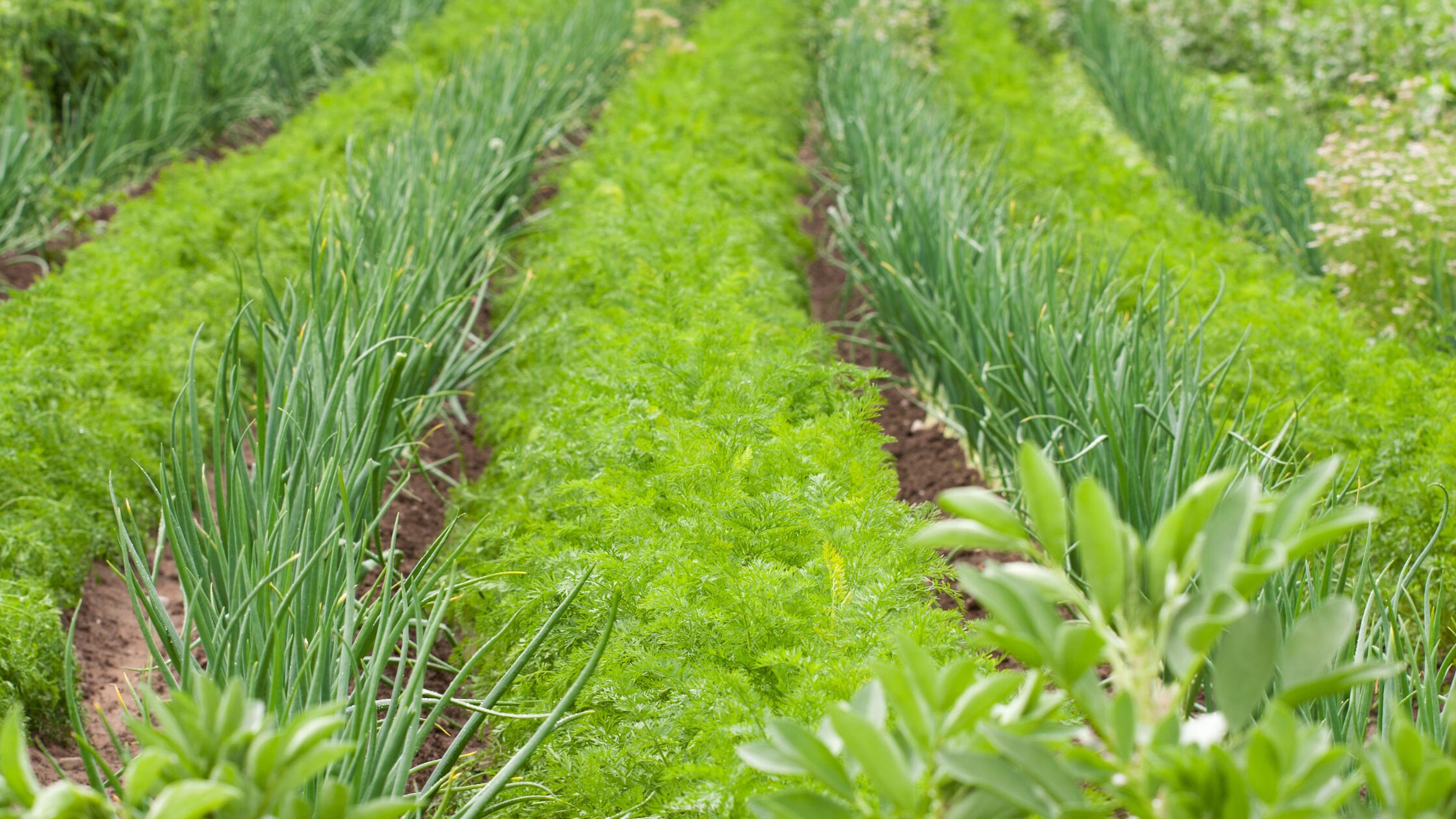
0 Comments